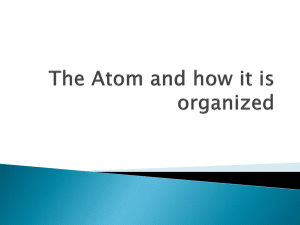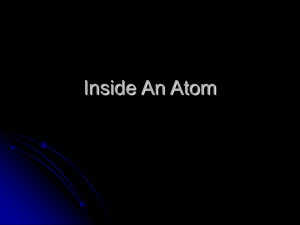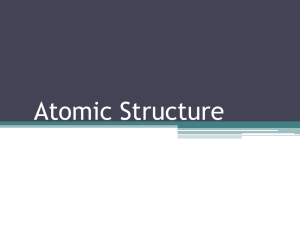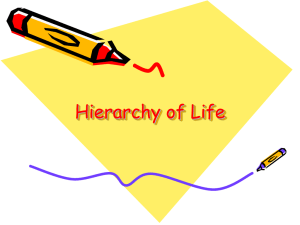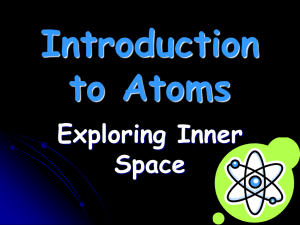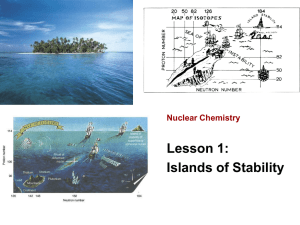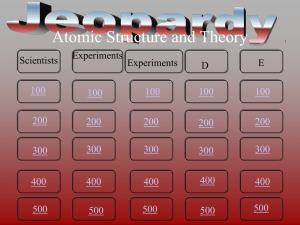atom
advertisement
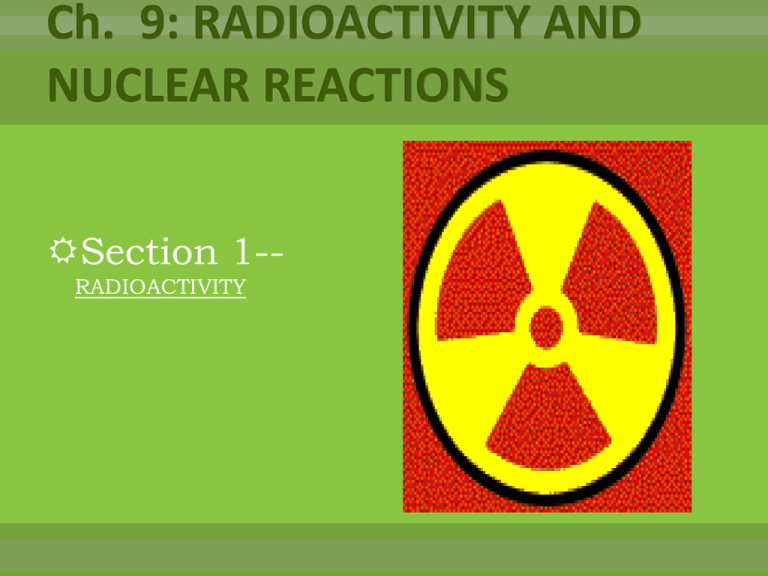
Ch. 9: RADIOACTIVITY AND NUCLEAR REACTIONS Section 1-RADIOACTIVITY What is an atom? An atom is the smallest piece of matter. Atoms are composed of protons, neutrons, and electrons. Ex. The element silver is composed of only silver atoms. The element hydrogen is composed of only hydrogen atoms. Nucleus = protons + charge neutrons no charge Outside the nucleus = electrons - charge (neutral) Atomic Number = # of protons Atomic Mass = # of protons & # of neutrons Element Atomic # Uranium 92 U Symbol Atomic Mass 238.029 PROTONS The total amount of charge in a nucleus is determined by the number of protons, which also is called the atomic number. Atomic number = number of protons ELECTRONS Negatively charged electrons are electrically attracted to the positively charged nucleus and swarm around it. An electron has a charge that is equal, but opposite to a proton’s charge. Atoms usually contain the same number of protons as electrons. # of protons = # of electrons PROTONS AND NEUTRONS IN THE NUCLEUS Protons and neutrons are packed together tightly in the nucleus. The region outside the nucleus in which the electrons are located is large compared to the size of the nucleus. Nucleus/Atom VS. Marble/Stadium The size of a nucleus in an atom can be compared to a marble sitting in the middle of an empty college football stadium. Where is the majority of an atom’s mass? The nucleus contains almost all the mass of the atom, because the mass of one proton or neutron is 2,000 times greater than the mass of an almost electron. MASSES PARTICLE RELATIVE RELATIVE ACTUAL CHARGE MASS MASS ELECTRON 1- PROTON 1+ NEUTRON 0 1 1836 9.11 X 10-28 1 1.674 X 10-24 1 1.675 X 10-24 HOW ARE PROTONS AND NEUTRONS HELD TOGETHER SO TIGHTLY IN THE NUCLEUS? Usually only positive (+) and negative (-) charges attract, but another force, called the STRONG FORCE, causes protons and neutrons to be attracted to each other. (STRONG FORCE HOLDS NUCLEUS TOGETHER) FOUR BASIC FORCES 1) GRAVITY 2) ELECTROMAGNETIC 3) STRONG (NUCLEAR) The strong force is one of the four basic forces and is about 100 times stronger than the electric force. 4) WEAK (NUCLEAR) SHORT-RANGE FORCE Protons and neutrons have to be close together, like they are in the nucleus, to be attracted by the strong force (SHORT-RANGE FORCE) (ONLY WORKS OVER SHORT DISTANCES—small atoms) LONG-RANGE FORCE The electric force is a long-range force, so protons that are far apart still are repelled by the electric force. (ONLY WORKS OVER LONG DISTANCES—LARGE ATOMS) RADIOACTIVITY SMALL ATOMS LARGE ATOMS SF >(greater) EF EF >(greater) SF STABLE Unstable Particles repel; give off matter and energy. This process of nuclear decay is called radioactivity. LARGE ATOMS LARGE nuclei tend to be UNSTABLE and can break apart or decay. ALL nuclei that contain more than 83 protons ARE radioactive (ATOMIC NUMBER >greater than 83) ISOTOPES Nuclei that have the same number of protons, but different number of neutrons are called isotopes. EXAMPLE— U-235, U-238 Same element (URANIUM) At. # = 92 Different # of neutrons (U-235 = 143 n)best (U-238 = 146 n) CHAPTER 9: RADIOACTIVITY AND NUCLEAR REACTIONS Section 2—NUCLEAR DECAY WHAT IS NUCLEAR RADIATION? When an UNSTABLE nucleus decays, particles and energy are emitted from the decaying nucleus. These particles and energy are called NUCLEAR RADIATION. (Also known as NUCLEAR DECAY AND RADIOACTIVITY) WHAT ARE THE 3 TYPES OF NUCLEAR RADIATION? The 3 types of nuclear radiation are alpha, beta, and gamma. Alpha and beta radiation are particles (matter) Gamma radiation is not a particle; it behaves like a wave; similar to light; electromagnetic radiation; most dangerous ALPHA PARTICLES Made of protons and neutrons Cannot pass through low density materials, such as a sheet of paper SMOKE DETECTORS some give off alpha particles; smoke disrupts process and alarm goes off (Americium-241) What happens when an atom no longer has the same number of protons? It is no longer the same element. (The number of protons identifies the element as a particular element) Transmutation is the process of changing one element to another through nuclear decay. BETA PARTICLES Made of protons, neutrons, and electrons Caused by another basic force—the WEAK FORCE Much faster and can pass through low density materials, such as paper, but are stopped by aluminum foil GAMMA RAYS They are NOT made of protons, neutrons, or electrons They are a form of radiation called electromagnetic waves They are able to travel through low and medium density materials, such as paper and aluminum foil; but are blocked by high density materials, such as lead and concrete Is RADIATION harmful? Damage from alpha and beta particles and gamma rays can cause cells in your body to quit functioning properly, which can lead to illness and disease. How does someone protect themselves? 1. TIME (around material) 2. DISTANCE (from material) 3. SHIELDING (safety equipment) 4. ROUTINE MONITORING RADIOACTIVE HALF-LIFE The half-life of a radioactive isotope is the amount of time it takes for half of the nuclei in a sample to decay. Some decay to stable atoms in less than a second. Some require millions of years to decay. RADIOACTIVE DATING Some geologists, biologists, and archaeologists are interested in the ages of ROCKS and FOSSILS found on Earth. CARBON DATING –carbon-14 is often used to find the ages of objects once living. (Also, potassium-40) URANIUM DATING –uranium-235 can be used to estimate the ages of rocks. CHAPTER 9: RADIOACTIVITY AND NUCLEAR REACTIONS Section 3: DETECTING RADIOACTIVITY Because you can’t see or feel alpha and beta particles or gamma rays, you must use instruments to detect their presence. A Geiger counter is a device that measures radioactivity by producing an electric current when radiation is present. The intensity of radiation present is determined by the number of clicks or flashes of light per second. BACKGROUND RADIATION This type of radiation is not produced by humans. It comes mainly from Earth’s rocks, soils, and atmosphere (building materials—bricks, wood, and stones; food, water, and air) RADON GAS The largest source of background radiation comes from radon gas. Radon is produced in Earth’s crust by the decay of Uranium238. Radon gas can seep into houses and basements from the surrounding soil and rocks. CHAPTER 9: Radioactivity and Nuclear Reactions Section 4: NUCLEAR REACTIONS What is the first step in a game of pool? A similar result occurs when a neutron is shot into the large nucleus of a uranium-235 atom. The nucleus is split. The process of splitting 1 nucleus into 2 nuclei with smaller masses is called nuclear fission. The word “fission” means to divide. FISSION RHYMES WITH DIVISION The total mass of the products is slightly less than the mass of the original nucleus and the neutron. The small amount of missing mass is converted into a tremendous amount of energy. A chain reaction is an ongoing series of fission reactions. (Billions of reactions can occur each second) ↑ REACTIONS = ↑ ENERGY Nuclear fission is used to generate electricity and is used in nuclear weapons. The critical mass is the amount of fissionable material required so that each fission reaction produces approximately 1 more fission reaction (keeps chain reaction going— so won’t die out or grow out of control). U-235 (1 nucleus) Dynamite (1 molecule) U-235 30 million times more energy 1 gram of U-235 2 tons of COAL Even more energy can be released in another type of nuclear reaction called nuclear fusion. In nuclear fusion, 2 nuclei with low masses are combined to form one nucleus of larger mass. Extremely high temperatures are found in the center of stars, including the Sun. These high temps (millions of degrees Celsius) are related to nuclear fusion. A small amount of mass is changed into an enormous amount of ENERGY. Earth receives a small amount of this energy as HEAT and LIGHT. As the Sun ages, HYDROGEN nuclei are converted to HELIUM. (ONLY 1% OF SUN’S MASS HAS BEEN CONVERTED TO ENERGY—ENOUGH FOR 5 BILLION MORE YEARS) (SUN) (RHYMES WITH DIVISION)
